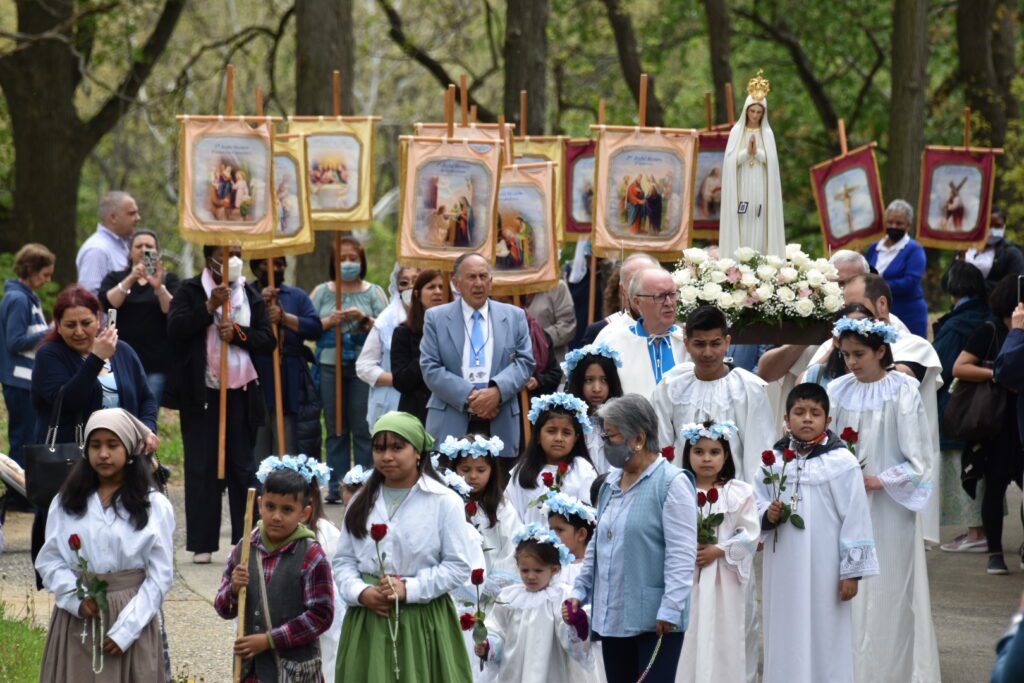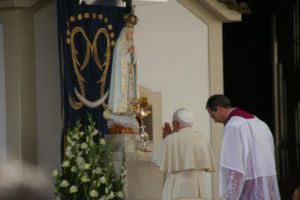

by Larry Maginot –
Less than two years before St. Faustina received the vision from Our Lord as the image of Divine Mercy, Sister Lucia also received a vision in Tuy, Spain, depicting the supernatural dispensing of divine mercy and grace for the salvation of souls. Based on Sister Lucia’s detailed description of the vision, various artists have rendered a version of what it looked like. Though the two visions are clearly distinct, their differences are not contradictory and can be understood in a way that helps each to shed light on the other and bring greater understanding to the whole Divine Mercy message. In St. Maximilian Kolbe’s Marian Consecration, he acknowledges to Mary, “God has willed to entrust the entire order of mercy to [her].” This acknowledgement is not depicted in the image given to St. Faustina, but with the description of Sister Lucia’s vision and some explanation of their unique perspectives, we can draw the connection.
Sister Lucia’s description of the vision given her at Tuy, Spain, June 13, 1929:
Suddenly a supernatural light illuminated the whole chapel and on the altar appeared a cross of light which reached to the ceiling. In a brighter light could be seen, on the upper part of the cross, the face of a man and his body to the waist, with a dove of light on his breast and, nailed to the cross, the body of another man. A little below the waist, suspended in the air, was to be seen a Chalice and a big Host on which fell some drops of blood from the face of the crucified and from a wound in his breast. These drops ran down over the Host and fell into the Chalice. Under the right arm of the cross was Our Lady (Our Lady of Fatima with Her Immaculate Heart, without sword or roses, but with a crown of thorns and flames), with Her Immaculate Heart in Her hand: … Under the left arm, some big letters, as it were of crystal-clear water running down over the altar, formed the words: “Grace and Mercy.”
St. Faustina’s description of the vision of Divine Mercy, from her Diary, Feb. 22, 1931:


I saw the Lord Jesus clothed in a white garment. One hand [was] raised in the gesture of blessing, the other was touching the garment at the breast. From beneath the garment, slightly drawn aside at the breast, there were emanating two large rays, one red, the other pale. … Jesus said to me, “Paint an image according to the pattern you see, with the signature: Jesus, I trust in You. I desire that this image be venerated, first in your chapel, and throughout the world.
I promise that the soul that will venerate this image will not perish. I also promise victory over enemies already here on earth, especially at the hour of death. I Myself will defend it as My own glory.” (Entry 47-48)
Both visions clearly show Jesus as the immediate source of divine mercy, but there are significant differences. The Divine Mercy image has been described as reflecting the miraculous post-Resurrection appearance of Our Lord to the apostles, who were gathered together behind locked doors. Integrally linked to Divine Mercy Sunday, the Gospel reading for that day helps provide context for the image:
On the evening of that day, the first day of the week, the doors being shut where the disciples were, for fear of the Jews, Jesus came and stood among them and said to them, “Peace be with you.” When he had said this, he showed them his hands and his side. Then the disciples were glad when they saw the Lord. Jesus said to them again, “Peace be with you. As the Father has sent me, even so I send you.” And when he had said this, he breathed on them, and said to them, “Receive the Holy Spirit. If you forgive the sins of any, they are forgiven; if you retain the sins of any, they are retained.” (Jn 20:19-23).
The Divine Mercy message draws much attention to “the hour of great mercy” (3 o’clock, when our Lord died on the Cross), yet the Divine Mercy image seems to only refer to this moment indirectly through our Lord’s wounds. It is Sister Lucia’s vision at Tuy that more directly appears to depict that “hour of great mercy.”
Our Lord told St. Faustina, “… Immerse yourself in My Passion, particularly in My abandonment at the moment of agony. This is the hour of great mercy for the whole world…” (Diary 1320). He later confided to St. Faustina, “The great sins of the world are superficial wounds on My Heart, but the sins of a chosen soul pierce My Heart through and through” (Diary 1702).
Our Lord seemed to be saying that what pained Him most in His moment of agony was being deserted precisely by the ones who had already become His apostles. He foretold this after the Last Supper: “You will all fall away because of me this night. …But after I am raised up, I will go before you to Galilee” (Mt 26:31-32). The image of Divine Mercy depicts our Lord’s post-Resurrection appearance to the very ones who were guilty of having abandoned Him “at the moment of agony.” Jesus then retroactively supplies the “grace and mercy” He gained for them from His heavenly Father precisely in that “hour of great mercy.” Is this why Sister Lucia’s vision at Tuy depicts the words “grace and mercy” flowing from the left hand of Jesus, rather than directly from the host and chalice or Our Lord’s wounded side?
The position of Our Lady “beneath the right arm of the cross” and the words “grace and mercy” coming down from “under the left arm of the cross” convey a symbolic meaning significant in the language of Sacred Scripture. In Scripture, the “right” and the “left” can hold opposing meanings. This is the case in Christ’s parable of the “sheep and the goats,” where at the final judgment the sheep are assembled at the right and the goats to the left (cf. Mt 24:31ff). According to the New International Dictionary of New Testament Theology, “The right hand symbolizes power, success, good fortune, loyalty,” and the left “folly and ill fortune.” Keeping in mind the symbolic nature of the vision, the meaning of Our Lady’s position in the vision would indicate her highly exalted position of influence before the majesty of God and her recognizable appeal to all her children in an effort to gain from them a similar sense of compassion. By the power of the intercession welling up from the depths of her Immaculate Heart, being extended to us in her hand for our consideration, she obtains “grace and mercy” for all of us who, though not deserving, stand in need. She appeals to the depths of human hearts, to consciences, to draw out, “with human chords” (cf. Hosea 11:4), compassion from us, so as to draw us ever nearer to the fount of that mercy – the pierced wound in the side of Jesus, made ever more accessible to all in the Church’s sacraments and liturgy.
We can thus affirm with St. Maximilian Kolbe that, though Mary is not the immediate source of God’s mercy, He was happy to lavish upon her “the entire order of divine mercy.” God has found in her Immaculate Heart an abundance of consolation. He calls all of us to join our hearts with hers at the foot of the cross to gain from her Son all the graces and mercy we and our world need to bring about the promised triumph of her Immaculate Heart.


Larry Maginot is a custodian for the World Apostolate of Fatima USA pilgrim virgin statue program, and author of the book “The Marian Manifesto.” This article was adapted from the book, which presents a thorough understanding of Our Lord’s request at Fatima for devotion to Mary’s Immaculate Heart and its relation to her promised triumph. It is available in our bookstore.











